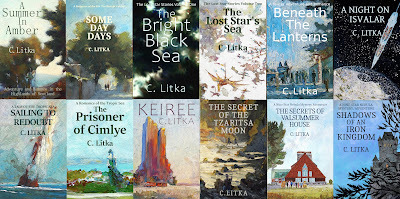C. Litka's Blog, page 39
November 4, 2021
Six & 1/2 Years in Self Publishing
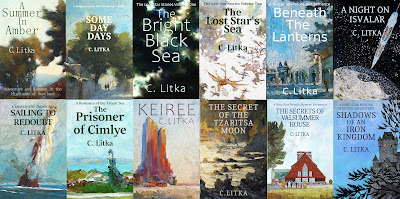
Once again, it’s time to report my first half sales – sales from May 2021 through October 2021.
Long story short: it was a good first half of my seventh year of self-publishing thanks to sales on Google.
Ireleasedonenew book a Nine Star Nebula Mystery/Adventure series, Shadows of an Iron Kingdom,on 15 July 2021 and one novella, A Night on Isvalar, on that date as well, which I wrote forAmazon’s Vella serial fiction service. After 30 days in Vella, I was also able to release it on Amazon’s KDP platform for Kindle Unlimited, as well. This novella is my only Amazon exclusiverelease. My thinking on writing and releasing A Night on Isvalar on Vella and the Kindle Unlimited was to use it as advertising for my other releases which, being mostly free and unadvertised, are likely never seen by most readers.. I don't think it worked. But we'll keep it in both services for now. On to the numbers.
My Sales Numbers
As usual, almost all of the sales are free ebooks sold through Amazon, Smashwords, Apple, and Google. My books are also available on Kobo, but they do not report free sales to Smashwords, and on Barnes & Noble which does report sales, but they don’t show up on my daily sales charts, so I don’t record those sales by the books – they’re just a rounding error anyway.. In addition some books are also listed on other sites that offer free books. I don’t know how many, if any are downloaded from those sites.
Below is the chart comparing sales for this first half of my sales year to my sales last year for this period along with each books total sales to date from the companies that report sales. (Numbers are approximate. None of them ever quite match up. Very quantum.)
Book Title / Release Date
1H 2020 Sales
1 H 2021
Sales
Total Sale To date
A Summer in Amber
23 April 2015
370
223
8,039
Some Day Days
9 July 2015
163
209
4,305
The Bright Black Sea
17 Sept 2015
542
511
14,053
Castaways of the Lost Star
4 Aug 2016
Withdrawn
Withdrawn
2,176
The Lost Star’s Sea
13 July 2017
439
506
7,475
Beneath the Lanterns
13 Sept 2018
253
438
3,230
Sailing to Redoubt
15 March 2019
221
441
2,773
Prisoner of Cimlye
2 April 2020
240
391
1.268
Lines in the Lawn
8 June 2020
55
13
96
Keiree
18 Sept 2020
174
367
950
The Secret of the Tzaritsa Moon
n/a
648
1758
The Secrets of Valsummer House
n/a
469
734
Shadows of an Iron Kingdom*
n/a
679
679
A Night on Isvalar*
(Amazon only – all $ sales only)
n/a
14
14
Total Six Month Sales
* New releases.
2,217
4,909
47,550
Sales at this point 2020:
38,273
12 month Sales:
9,277
Comparing last year with this year, my my sales split between Amazon, Google, and Smashwords (including sales on Apple and B & N) works out like this for last year (2020):
Amazon 35%
Smashwords (Apple & B & N) 39%
Google 26%
This year in this time period the split looks like this:
Amazon 32%
Smashwords (Apple, & B & N) 18%
Google 50%
First the numbers. It was a good first half of the year. I more than doubled my sales compared to last year, helped in part by four additional books for sale.This total exceeds my record 2019 sales for this periodwhich came in at 4,590 copies. Thanks to a surge in sales on Google, I moved 968 books in September and 1,236 books in October. Can't complain, but for both the monthly totals and the half year totals, it is important to keep in mind that this period has six more books for sale than I hand in the 2019 period. And have to also point out that in the month after the release of my 4th book, Castaways of the Lost star in 2016, I sold 838 the first month and 1,324 books the next, and with the release of The Lost Star's Sea, in 2017 I sold 1,205 that month and 831 the next. These days I have 11 books for sale and my monthly sales are similar to what they were when I was selling three or four books. As I've been saying for some time, it gets harder every year to sell books that are not precisely targeted and effectively advertised. Looking at the numbers it is also clear that mynewer books, the Nine Star Nebula Mystery/Adventure stories in particular are carrying us along especially on Google Their numbers are being held back somewhat because they are not free on Amazon US.
Significant trends
The headline news of my first fiscal half of the year is the performance of Google’s Play Store Books, especially in September and October this year. Belowis a chart of my Google sales for the last three years. As you can see, sales grew slowly for the first two years, started to takeoff at the start of 2021 and exploded in September and October.
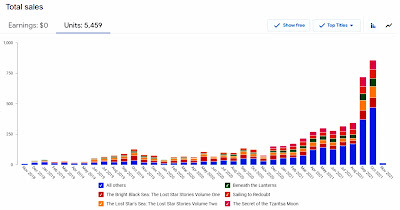
I have no explanation for this phenomena. Looking at the Play Store, I can see no reason for this jump in sales. None of the books are in the top 100 free, and when you go to the genre listing for science fiction, many of the categories are simply jokes, filled with a strange collection of books that have nothing to do with the supposed sub-genre. How readers find my books, or any book, is a mystery to me, save that if they do find one and like it,they search outthe others. I don’t expect this level of sales to continue, but I think it is clear that Google will continue to be a major contributor to my sales going forward.
Smashwords, on the other hand, continues to fade as a source of sales. New releases goose sales for a month or so, but even these peaks are ½ to 1/3 what they were in the 2015-2017 period. Once the peak is a month or so behind us, sales drop to less than150 books a month. Below is an incomplete chart from 2018 to date. Smashwords changed their storefront in January 2020 and my sales jumped and continued to sell well, until one day in October.. On the 6 October, something at Smashwords abruptly changed. I had no sales for that day, and when they resumed they were less than half of what they had been, and have continued that trend to the point where I sell as many books on Apple some months as I do on Smashwords. In the chart below you can see the spikes when I release a new book, which, as I mentioned are much reduced since the happy days of 2015 & 16.

Amazon is always a wild card. It is feast or famine. Amazon monthly sales in this period ranged from a high of 328 to a low of 130. As you can see for the 90 day chart below, you can go for a month with sales ranging from 0 to 10 copies a day and then get 50 sales in one day for no apparent reason.

Looking Ahead
I’m hoping to publish a new Nine Star Mystery/Adventure story in February or March of2022. I would like to write a longer, more ambitious novel after that, but then, I just spent a fruitless summer trying and failing to come up with just that, so we’ll have to see how that goes. New books drive sales, and without new books, sales languish, so it is hard to predict what lies ahead.
In addition, there areseveral wild cards in play. The first is that I entered A Summer in Amber in the Self Published Science Fiction Contest. Depending on how far it goes and how well or poorly it is reviewed, the contest might generate interest and increased sales for it and my other titles as well. Plus, next spring I expect to enter Beneath the Lanterns in a similar Self Published Fantasy Blog Off contest, thoughany results from that contestare likely 18 months down the road. Finally, I am also toying with the idea of spending some money promoting my books next year as well, but more on that after the first of the year.
Summing It All Up
I’m very happy with the way sales are going, though the future, as always,is up in the air.
October 30, 2021
National Novel Writing Month
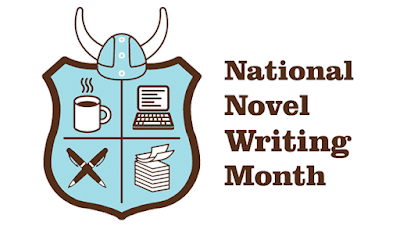
November is National Novel Writing Month – NoNaWriMo – where tens of thousands of writers and would-be-writers challenge themselves to write a 50K word novel in the month of November. There is a website for the project where you can sign up and I guess report your daily word count and compare it to others. I’ve never done it. However, this year…
As planned, I took the summer off from writing fiction to try to come up with a longer, more ambitious novel than the ones I’ve been producing recently. My Nine Star Nebula Mystery/Adventures have been fun to write, and hopefully fun to read, but they’re what I consider “stories” rather than “novels.” Light reading -- not that I want to write anything too heavy, just a story with a little more depths and expanse. However, I didn’t come up with anything worth pursuing, and now summer is gone and I'm left without a writing project to fill the dark winter days.
Well, here we are at the start of November, on the verge of six months of a Wisconsin winter, a long season that will keep me indoors all day, most days. Now, I’m already a level 93 Klondike “Champion” in MS Solitaire, so I really need something else to fill my days with a bit more, well, productively? I really need a story to write. I had started the sequel to Keiree, got 5,000 words into it, and decided that I didn’t like the way I had planned for it to go, so I put it aside. I have an alternate plot, but not in enough detail to start on it. So, it’s on to plan C…
Play C is The Aerie of a Pirate Prince (working title), a Nine Star Nebula Mystery/Adventure. I had wanted to put that series into hiatus, but it is doing well in the Google Play Store, if not anywhere else. Nothing is doing particularity well anywhere else. In any event, over the last several weeks I have worked out a mystery adventure story featuring Rafe d’Mere and Kee in my head. With the last story I wanted to give it a bit of Gothic air, and this time around we’re shooting for a hard-boiled detective noir air. I’ve got the action taped out for the story, but it's hard at this point to estimate how many words it will take to tell the story. But I think it should land in the 50-60K word range. With all the action set pieces plotted, I think I should be able to finish this one.
So, while I am not going to sign up for NaNoWriMo -- I don’t like word count goals, I’m content just to put in the time and let the word count take care of itself, I am going to try to finish the first draft of this story by the end of the month, or at the latest, mid-December. We'll see how it goes. Six weeks for a 60K story is not all that much of a reach for me, if I have the story well in mind before I start. I think I have the story in mind, but you never know... We'll see. Stay tuned.
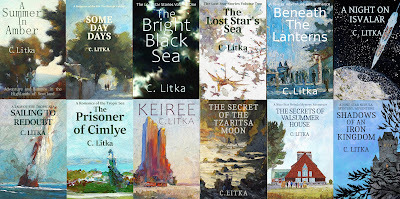
October 28, 2021
The Sound of Silence
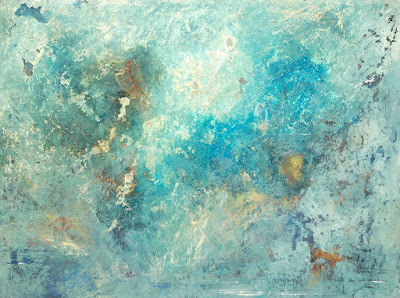
I’m typing this without music in the background. And it’s a little bit eerie The reason for the silence is that Spotify up and eliminated my “Unlimited” tier, which I’ve had for the last ten years – ever since Spotify arrived in the US. For $5 a month I enjoyed the full Spotify, except for being able to use it on mobile devices. Not that my smartphones never had the bandwidth for it anyway -- when I have it on. Now I either have to pony up an extra $5 a month or put up with ads on the free tier. With 2 minutes of ads every 10 minutes, the free tier is a non-starter. And that extra $60 a year… well, we’ll see. I may get used to silence.
Still, silence is a big change for me. For the last twenty years and more, I’ve listened to music whenever I was painting, writing, or working at my desk using my Tivoli Audio Model Two as speakers. Back in the waning days of the last century, I stayed up late on the weekends to record three hours of Jazz With Bob Parlocha, a mainstream jazz radio show broadcasted by our state’s public radio network. I converted each hour into a mp3 track and burned those shows onto a CD. I ended up with a hundred disks of about 10 hours each so I could listen to them when I was fully awake and painting.
That changed when the online music service Lala became available and I signed up for it. With Lala I was able to listen to every tune once for free. Then, if I wanted to add it to my streaming library I paid a dime per tune. If you wanted to buy it, it was the usual $.99. Listening to Lala introduced me to a wide variety of music genres, expanding my taste in music far beyond jazz. In the few years it was available, I acquired a small streaming library which I recorded using my handy-dandy iRiver mp3 player. Luckily, I still have those tunes, so if silence gets too eerie, I can turn back time a decade or so to my Lala days. Apple bought up and closed down Lala, and I haven’t forgiven them for that.
Ten years ago, Spotify became available in the US and I signed up immediately. All my books have been written with Spotify playing in the background. I continued to explore many facets of music, while avoiding others, like country, rap, and most classical music.
The strange thing about all this is that I’m not an audio-focused person. I can’t just sit and enjoy music as audiophiles can. Music doesn’t hold my attention. My wife will often remark about something that she hears – a dog barking, a bird singing – that I no doubt heard, but it never registered with me. And for the most part, this is also true of the music I listened to when I’m writing at my desk. Oh, sometime I’d pause and listen to it – but much of the time it goes in one ear and out the other without leaving a trace. Indeed, I have a whole playlist – called “Favorites” – of songs that actually caught my attention when I was working -- songs that for some reason resonated with me. Nevertheless, I have collected many days worth of songs in different playlists – soundtracks, piano music, some European jazz, and semi/modern compositions, that I enjoy, but yet, will mostly drift by without me consciously noting them.
And yet, I can feel its absence as I write this piece, so music must do something. I want my full range of music back. But I’m willing to hold out until I get some incentive to began paying Spotify again for it. What makes this decision a bit easier is that I’m not actually writing fiction at the moment. My Molly, Mons, and Mars story is on hold, though I'm planning to start a new Nine Star Nebula mystery/adventure story on 1 Nov -- and unofficial NaNoWriMo effort. We'll see how it goes. In any event, these weekly blog posts have been about my only exercise in writing all summer. Still, I guess I can slouch on until Spotify becomes desperate enough to get me back and offers me a deal I can’t refuse.
In the meanwhile, I will just revisit my old music, all those Lala tunes, and if I can find a CD player that works, all those Jazz with Bob Parlocha tunes as well.
By the way, if you have Spotify and are curious to know the music behind my stories, you can find some of the playlists that I made public on my profile – charleslit is my user name. Many of the playlists are just collections of songs or albums that I don’t want to lose track of – they are not artistically arranged.
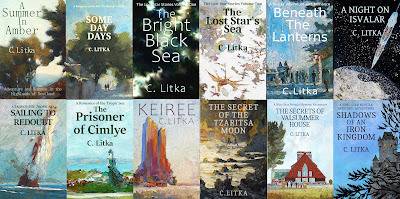
October 21, 2021
Pushing Ice, by Alastair Reynolds A Review
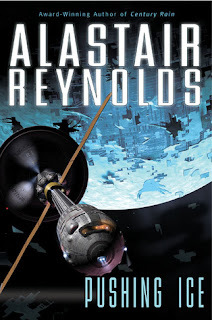
All the cool kids on the SF booktube, Media Death Cult, I watch have been reading Alastair Reynolds books, so when I found one at a local charity shop, I picked it up. It happened to be Pushing Ice, one of his stand alone books. Below is my review of that book. Unlike Reynolds’ book, I won’t spoil the review in this prologue.
Pushing Ice
By Alastair Reynolds
The reviewer’s bias: I prefer stories with well developed, pleasant characters. I like writing that is clever and witty – entertaining in itself. I prefer first person narratives, or close third person narratives. I dislike thinly disguised fanfic or stories with gaping plot holes.
Pushing Icebegins with a prologue set 18,000+ years in the future – a future with thousands of human inhabited planets. A politician wants to honor the “Benefactor and her people” are who are “still out there and moving away from us,” far away, but less than 18,000 light years away. The Benefactor is Bella Lind.
The first chapter then introduces us to comet ice mining rocketship Rockhopper, the actual story set, according to the back cover blurb, in the year 2057. I am always amazed at the optimism of science fiction writers. To have nuclear powered space ships pushing around comets 52 years from the date Reynolds wrote this book is pretty damn optimistic.
The Rockhopper is captained by Bella Lind, the eventual Benefactor. As the story opens, a minor moon of of Saturn proves to have been an alien artifact by breaking free of its orbit and heading out of the solar system. Captain Lind’s Rockhopper is the only (non-Chinese) ship in position to intercept and investigate the artifact for the few days they would have before having to turn back, and only if they push their ship hard. They are tasked with the mission and agree to head out to intercept the artifact.
The prologue basically tells the reader that they succeed in intercepting and gathering enough data to eventual create an interstellar human society. And it also tells us that the Rockhopper never returns to the solar system, since it is still moving away, 18,000 years later. So the reader knows “who did it,” leaving the story to tell the “how.”
Foreshadowing is once again used several chapters in. He begins a section with the line: “No death in a spacesuit is ever good, but Mike Takahashi’s was especially bad.” And proceeds to spend the next 13 pages describing the failed rescue attempt in great detail.
Since the reader already knows that the Rockhopper will not return to the solar system, as planned, the only question is what goes amiss? As it turns out, there is an onboard accident that suggests that the fuel tanks have less fuel than what they should have according to ship sensors. How did this happen? It is suggested that the numbers were tampered with by the ship’s owners back on Earth via a software upgrade or bug fix. I can’t say for certain if this is the cause, since I did not get much farther in the book. I found that I couldn't believe this, and gave up around page 125 out of 780 pages. This may've been a red herring, but it doesn't matter, they don't return.
So why the DNF? I like character driven stories with at least a few pleasant characters. Reynolds introduces what seems like several dozen characters in the first couple of chapters in a shotgun spray of conversations laced with dense techno-minutia details and fragmented backstories. My wife will write down names of characters in books to keep them straight, but I’m not one to do that. When there are too many characters tossed at me at once, willy-nilly, I just don't care about any of them. They all tend to fall under the category devices designed to provide background info and world building rather than people. Basically, they’re interchangeable, and while they may become more distinct later on, I’m still not likely to care about them. And this criticisms includes our main protagonist, the Benefactor, Captain Bella Lind.
While Bella is presented sympathetically, I felt that she was not in the story enough at this point to anchor the narrative. First, she’s in and out of it, with all the other bit players speaking their parts, often on tangents (at least in the first hundred twenty plus pages of the story). Secondly, Reynolds has her do something that doesn’t seem in character, no doubt in order to set up a conflict. After that accident aboard ship, on day 11, Chapter 4, Bella’s best friend aboard the ship is the person who discovers the apparent discrepancy between what the fuel data says now and what it said before it was altered. Bella doesn’t entirely believe her and contacts the managers of the mission on Earth regarding the discrepancy – who, of course, deny it is possible, and suggest that the person reporting it has gone off the deep end. To check on it herself, she and the corporate guy who is second in command, go down to the section of the ship to collect this data themselves – while Bella’s best friend is sleeping. As the captain of the ship, there is no reason why they needed to do this behind her back. The captain would have every right to investigate the issue herself when her friend was on duty. Indeed, you would expect a captain to do just that. The only reason for witting this scene this way was to set up a conflict. This was the part that sent my book flying, if not across the room and into the wall, but across the table next to me. I found that I couldn’t like any of these people and didn’t care what happened to them.
Reynolds is an astro-physicist who writes like one. His writing is very dense. It is nondescript in the sense that it doesn’t get in the way of the story, save that all the techno-minutia and snippets of dialog between lots of characters make for slow going. He is very interested in both tech and big sweeping ideas. He seems to use people as talking points, like many classic SF writers did. Now on one hand, all this techno-info may serve to build his world, but on the other, because the characters are pretty nondescript at this point, I found myself thinking “Who cares?" get on with the story." To that end, I found myself constantly skim reading. In short, it’s slow, heavy, unengaging reading for a reader like me. Your mileage, will, of course, vary.
So, to sum it up for me – I felt that Reynolds' use of foreshadowing diminished not only the suspense of the story, but my desire to push on, knowing how it ultimately ends. "Mind blowing" ideas and revelations are not my cup of tea, I simply didn't care what they will find on the artifact. There were no characters that I liked. I felt that he was setting up a lot of conflict within the crew which would make unpleasant reading for a reader like me. I didn’t believe for a minute that the managers on Earth could add 16% more fuel to the ship's log without someone onboard noting the change in readings. Not to mention that fact that the people on Earth could ruthlessly send the ship and people on a mission that they knew was a suicide one. In short, a lot of unpleasantness.
Goodbye, Alastair Reynolds, it’s on to D E Stevenson’s The Two Mrs. Abotts.
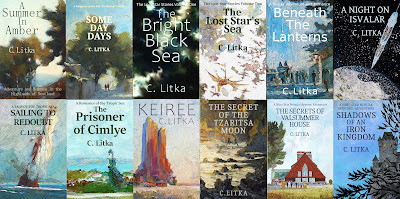
October 14, 2021
#$@%$&&$!!%$)*%!
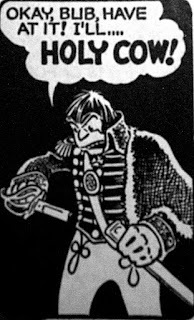 Not exactly swearing
Not exactly swearingI recently watched a Youtube video by an author discussing swearing in books, and I thought, damn, I can use that subject for my weekly blog posting. So here we go.
I have nothing against swearwords. I’m not morally offended by them. Swearwords are just words, which is to say, they are tools that are used to convey information or emotion. Swearwords, for the most part convey emotions – surprise, anger, threats – and are not to be taken literally. Sometimes they act as merely grace notes, peppered unconsciously throughout a conversation, as in, “Shit. Pass the fuck’n salt. This stew tastes like crap.” They add color to the language.
While I think that they certainly have a place in storytelling, I don’t think they are necessary in telling a story. For a number of reasons, I rarely use swearwords, and the ones I use I mostly use as are grace notes to define characters.
The first reason I generally avoid the over use of swearwords is that words on a page are tone deaf. They are without inflection. If I uttered aloud the phrase above, its swearwords would likely pass unnoticed by most people. But written, a reader notes every one of them. They are heavy words. They come with the burden of being “forbidden” even if commonly used and the reader does not find them offensive. And because of this, I think they should be uses thoughtfully.
Character is the key here. Who uses swearwords and how often depends on the characteristics of the character. In most cases, it would be hard to write the above phrase as casual dialog without using some crude language and make it sound like dialog. “Pass the salt, this stew tastes bad,” doesn’t sound like casual conversation. However, in polite society someone might say, “Please pass the salt, this stew seems rather bland.” In both cases crude words are avoided, but one sounds wrong, the other right, in a certain circumstance.
It is possible for the frequent use of swearwords to be used as a tag line for a character. But if every character uses a lot of swear words – if they become a commodity and lose a lot of their value.
A second reason I generally avoid swearing is that swearing is associated with crude, uncouth people. While the use of swearwords is hardly confined to uneducated and uncouth people, given the weight of swearwords in the written language, the frequent use of them in text would tend to make any character sound uncouth, if not uneducated. On the other hand, if it is the writer’s intention to make a character uncouth, or threatening, then the use of crude and harsh language is one way of creating that character. So swearwords have their uses.
A third, and very significant reason why I don’t make extensive use of swearwords, is that most of my stories are set in the far future. The distant future I envision as being a post-religion society, one where religion has faded from memory. People may still be superstitious, but an organized religious structure and afterlife are long gone. Thus, concepts like god, hell, damnation, etc. and with them, phrases used to describe those ideas have all faded away as well. A word like “goddamn” would have no meaning whatsoever in a future without a concept of a god who's a guy who toys with the people he makes. A great deal of swearing involves god, hell and damnation.
Still, there is perhaps a need for similar phrases. In my Nine Star Nebula stories, I substituted “Neb”, short for nebula, for “God” with the idea that the all-encompassing nebula might have a perceived presence or personality – a lingering superstitious human trait.
Once you’ve taken religion out of swearing, you are largely left with sex and sexual ancestry. Sex probably isn’t going to fade away. However, the problem with using sexually orientated swearwords and phrases is that they often sound contemporary. Sex in the future isn’t likely to change enough to create a whole new class of swearwords. And if it does, they probably wouldn’t resonate with today’s readers. Now there may well be authors who can invent swearwords and phrases that sound futuristic while still conveying the heaviness of swearwords on a page, but I’m not one of them. Indeed, I’m not good at inventing cursing and swearing, period. And since I’m not good or creative at swearing, I’m content just to have the narrator mention that a character is swearing, and then doesn’t bother transcribing it. This is not squeamishness on my part, just a lack of talent in that field of writing.
So, to sum it up. I don’t have a lot of swearing in my books. This is not a result of any objection to swearing on moralistic grounds. Nor any desire for a YA audience (Heaven forbid!). It is the result of wanting to use what swearing I do include to it greatest effect. And a desire not to kick readers out of the future I am trying to build by slotting in phrases that sound too contemporary.
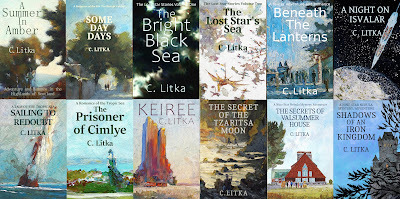
October 7, 2021
A New Old Cover
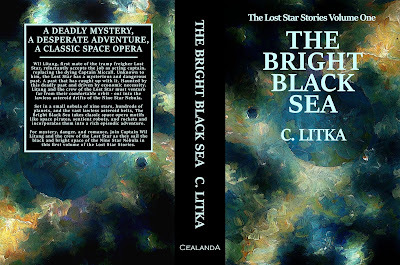 The newer, but now old cover for the paper edition
The newer, but now old cover for the paper editionNothing exciting to talk about this post – just like every other post. One thing that is new – is that I have a new cover for the paper version of The Bright Black Sea. I had updated it this summer, twice, in fact. The cover above was the second version. I flipped the cover art and changed the title to light blue to make it easier to read. However, I had time on my hands, and seeing that's the devil's playground, I decided play around with it. My major incentive was to rewrite the back page blurb, but it was mostly just for something to do. Since I rarely sell any of the paper version of any of my books, making changes to them is almost pure art – an exercise in creativity. In the process of revising my blurb box I came across all my old designs and decided to see how I might redesign the entire cover using the art I used for the first edition.
I thought I might well go through the steps of creating the new cover art, so below is the actual starting point of the art for the cover, As you can see, it is not a space scene, but a rather abstract rather Chinese style landscape.
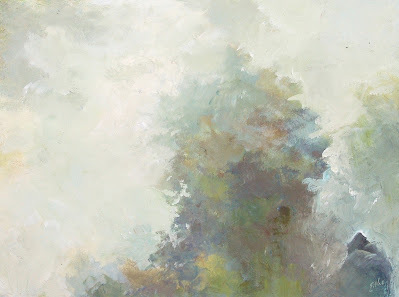 The original painting in its original orientation.
The original painting in its original orientation.
In the image software program Gimp, I take this rather abstract landscape, and “inverse” its color, flip the image and then rotate it to change the image into this:
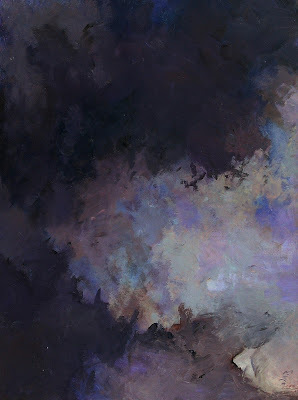 Colors inverted, flipped and rotated. The house is still visible in lower right hand corner
Colors inverted, flipped and rotated. The house is still visible in lower right hand cornerI smudge out the house, adjust the color brightness and contrast to get the image to "pop" a bit more, and then add a glowing star in the center of the nebula using the “nova” filter in Gimp to get this image:
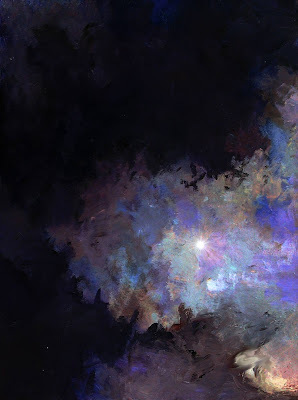 This was similar to my original cover art.
This was similar to my original cover art.
I wasn't quite happy just yet, and playing around with the filters in Gimp, I found one that adjust the color temperature of the art, making it a bit warmer, richer toned, to get it to look like this:
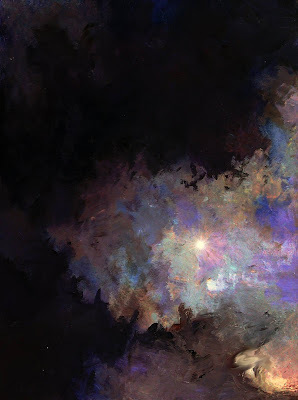 A slightly warmer, richer tone, a bit more inviting, I think.
A slightly warmer, richer tone, a bit more inviting, I think.
Below is the finished cover, after I eliminated that white rectangle and adding the title and the new back cover blurb box. I used the same art rotated for the back cover.
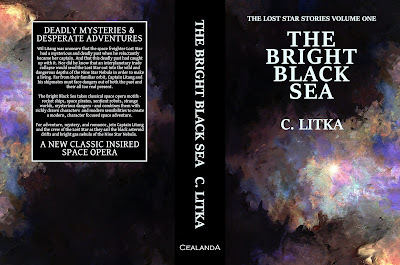 The new cover with the old, original art.
The new cover with the old, original art.For comparison, below is the original ebook cover. At the time of first publication, I did not offer paper books.
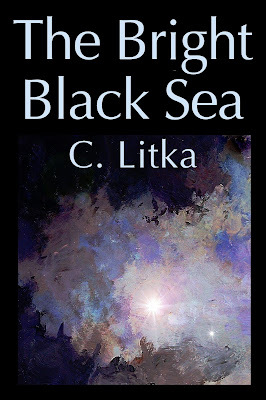
I will keep my current ebook cover, as I like it, and since it is usually only seen in thumbnails, the larger title comes in handy. However, I don’t think that large text would work well on a paper book.
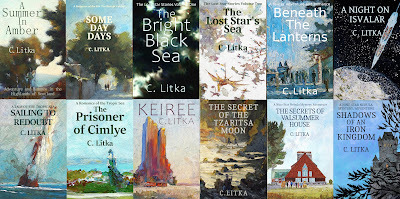
September 30, 2021
Self Published Science Fiction Contest
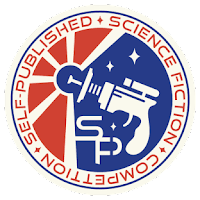
I am likely the least competitive fellow you’ll ever come across. For me, the agony of defeat far exceeds the thrill of victory. Competition produces losers, not winners. Unless you are talking about a one on one competition, competition produces far more losers than winners. Producing losers seems to me to be a rather unrewarding undertaking. Nevertheless, I recently entered a competition.
The competition is the Self Published Science Fiction Contest. Inspired by the fantasy writer Mark Lawrence’s Self Published Fantasy Blog Off, that he has run for the last seven years. The science fiction version of this is being run by Hugh Howey and Duncan Swan for the first time this year. Up to 300 self published science fiction writers can toss one of their books into the ring. These books are divided among 10 teams of readers from 10 blogs. Each team reads 20% or so of all 30 books that they are assigned to read, choosing their top ten to finish reading. From these ten they choose their top 3 books to pass along to all the rest of the readers. These 30 semi-finalist are given a score of 0 (DNF) to 10 by all the readers. The ten top rated books are reviewed on the participating blogs and Goodreads and the book with the highest rating overall wins the competition. The purpose of this contest is to gain some exposure for the authors and their books and hopefully with that, sales. On the fantasy side, several of the finalist have been picked up by traditional publishers.
Avid readers of this blog may recall that in 8th grade I entered a piece of (bad) art in a contest and didn’t win a damn thing. This soured me for life on contests. Still, I think that after 55 years, I have perhaps, outgrown that humiliating defeat. In any event, I feel that any positive exposure this contest might generate is worth risking another such defeat. Free advertising is a shining city on the hill for me.
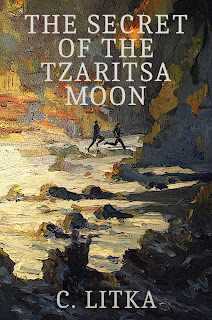
The question then was, which of my books should I enter? My most popular title is The Bright Black Sea, but seeing that it is 700+ pages long, I didn’t think a book that long would’ve been welcomed by the contest judges, so I eliminated that one, along with its sequel, since the rules require the entry to be the first book in a series or a stand alone book. Beneath the Lanterns is my one fantasy(ish) book, and I plan to enter it into the fantasy contest next year, since I missed the deadline this year, so that book is out. I like Sailing to Redoubt a lot, but its SF elements are rather minor, andSome Day Days contains my earliest work, and its not very SF-ee either. That left A Summer in Amber and The Secret of the Tzaritsa Moon to choose from.
It was a hard choice. I’d like to think that I’ve gotten better at writing as the years have gone along, so that Tzaritsa Moon should be a technically better written book than A Summer in Amber, which was my first published piece. However, Tzaritsa Moon is half the length of A Summer in Amber at just under 65,000 words, and while it was a fun piece to write, and hopefully a fun piece to read, I consider it light reading. While the word count is well within the novel range, I consider it more of “a story.” A Summer in Amber, on the other hand, is not only twice a long, but it has a lot more going on within the story. I consider it a novel. And I while I try not to pick my favorites among my books – that summer in Scotland is almost real to me. So I was left with a decision – should I chose a hopefully better written story or an older, but a richer novel?
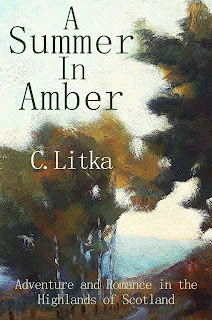
I opted for the richer novel – A Summer in Amber. I think that it will stand out among the contestants, for better or worse, whereas The Secret of the Tzaritsa Moon would’ve been just another short, self-published SF novel.
The blog that will be making the initial determination for my story is Fantasy Factionblog. As of this posting, A Summer in Amber sits in a quantum state – it can advance or be eliminated. If I’m lucky and it somehow avoids being cut early, I may not find out its fate for month. But its fate could be decided in only a few weeks. Stay tuned.
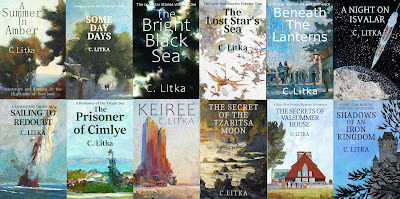
September 24, 2021
Islandia
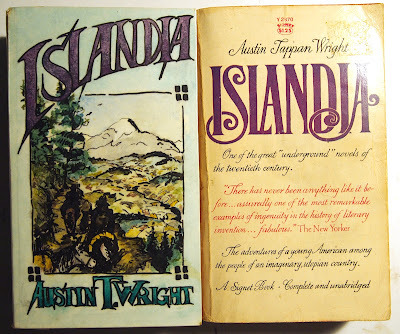 Right: The original plain white cover. Left: The cover of my first book fell off, so I made a new cover for it.
Right: The original plain white cover. Left: The cover of my first book fell off, so I made a new cover for it.Last night I didn’t have anything prepared for this week’s blog post. My conversational fallback is to talk about the weather. Hoping to avoid a weather report, I came up with this essay. We’ll save the weather for another post.
It's funny the little things I remember, when as a general rule, I forget everything. For instance, I understand that I lived throughout the 1980’s – but I don’t think I've any authentic, first person memories of doing so. I can work out what I was doing during those ten years – sort of – and from that knowledge I can reconstruct some incidents from that era – as in I know I had to have done this or that. But I gather that most people are able to actually relive, in their minds, hours and hours of actual incidents from their past. I’ve never been able to do that for that reason. So it is remarkable when I do remember an incident at all. Indeed, I based one of my novels, Sailing to Redoubt, on a remembered dream from when I had to have been five to seven years old. Which brings me around to the subject of this post: Islandia.
I have a distinct memory of picking up and looking over the book pictured above (on the right): Austin Tappan Wright’s utopian/fantasy/make-believe world Islandia. I have no idea why I remember doing so. Though to be clear I remember doing it -- I can't recall the actual scene. The memory goes back to 1966 when this version was released. I know that it wasn’t in the usual card shop where I purchased most of my books back in those days, so it must have been a book shop -- Walden’s? or B Dalton?
As you can see, the cover is plain white (ala White Album?) with the title and the blurb “One of the great “underground” novels of the twentieth century.” It was a big thick book – 944 pages thick. The back cover, like the front cover had the title, some blurbs from the New Your Times, the New York Herald Tribune, and Orville Prescott, whoever he was. Plus a brief synopsis;
“ISLANDIA has been an underground classic for over two decades. Signet’s republication of this great book brings before the public one of the most staggering feats of literary creation – a detailed history of an imagined country and a young American’s adventure there… among the people he met and the women he loved.
THE SPELL OF ISLANDIA IS POWERFUL. As Norman Cousins described the book’s power in The Saturday Review: “Islandia, like life, was rea l ; Islandia was earnest. Little by little it became recognized for the miracle it was.”
I considered buying it, but in the end passed on it – it was probably in the science fiction section, or I would never have come across it, but it wasn’t science fiction enough for me to plunk down the $1.25 (when most paperbacks were $.50 - $.75) back then.
But, for some reason I never forgot it. And perhaps 12 years later, I'm vague on the date, but I know the place, I came across a copy of it in Oklahoma Street Library, pulled it off the shelf and started reading it. It wasn’t my local library so I couldn’t take it home, but once again, strangely enough I remembered the incident.
A few years later, likely in the early 1980’s I think that I found a copy of it at the annual Bethesda Fair rummage sale, and this time purchased it, though I’m not certain about that. All I actually remember is spending my evenings for at least a week traveling through Islandia with a bowl of popcorn at hand. It’s a little bit slow at the beginning, but it slowly draws you deeper and deeper into its world, more real than any other imaginary setting that I’ve ever read.
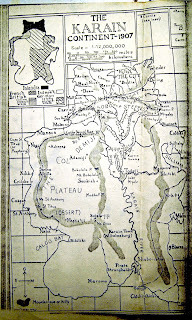 One of Wright's maps of the Karin Continent. Islandia is on the top, the dark black area in the small map, with the shaded areas showing areas of European influence and concessions.
One of Wright's maps of the Karin Continent. Islandia is on the top, the dark black area in the small map, with the shaded areas showing areas of European influence and concessions.Islandia was Wright’s imaginary world, a world that he had spent his life imagining. Islandia was a country at the northern end of an imaginary continent called Karin in the South Atlantic Ocean. He created its history, its language, is geography and geology. It was probably as real to him as his “real” life. In writing this account of a young American discovering his strange and wonderful land, he draws us into his all-but-real world. Perhaps because this was his private make believe world, not something he thought up for a book, there is an authenticity to it that you can feel.
The book was only published after his death. The manuscript, of nearly 600,000 words that he had left behind, was edited down by about 1/3rd. As his daughter wrote in the introduction, “....my father knew the exact lineaments of every scene John Lang saw down to its geological causes, and enjoyed describing such things.” He also wrote a 135,000 word history of Islandia., plus a large volume of appendices to the history, including a glossary of the Islandian language; a bibliography; several tables of population; a gazetteer of the provinces with a history of each; tables of viceroys, judges, premiers, etc., a complete historical peerage; notes on the calendar and climate; a few specimens of Islandian literature, 19 maps, and one geological map.
You can find a complete review of the book here: Islandia Review
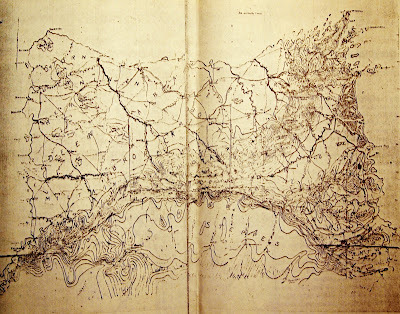 A map of Islandia, though hard to read.
A map of Islandia, though hard to read.I believe that I’ve read the entire book twice. Maybe I’ll travel to Islandia again some day. But it’s a place I know I’ve visited, even if I can’t remember it all. However, I will say this; the book has, in my opinion, one flaw. As it says on the back cover “Islandia, like life, was real; Islandia was earnest.” I don’t recall one humorous scene in the entire 944 pages. It is an earnest book.
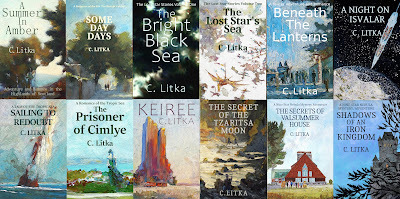
September 16, 2021
My Top 10 Favorite SF Books of All Time
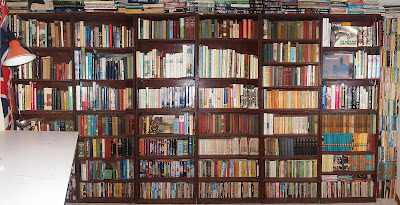
I recently watched a Media Death Cult video on the viewers' favorite books and I have to admit that haven’t read more than one or two of them. Still it got me to thinking about my favorite books of all time. So I racked my memory to come up with a list of my ten favorite SF books. This proved to be rather hard since I've forgotten 97% of them. On the flip side, it means that if I do remember them, and remember really enjoying them -- they're a candidate for the list.
Before I begin, I should note that “all time” is the trick words here. What I’ve done is try to recall what were my favorite books during my nearly sixty years of reading SF, in one era or another. They are not necessarily my favorite SF books today. Indeed, most of them would not even being the running today, since my tastes have evolved over my lifetime. Still, at one time, they were my favorite books and I still recall them fondly because of that.
All but two of the books come from my early years of reading SF in the 1960’s and early 1970’s when I was reading 50 to 100 books a year. This means that most of the books are classic SF. I'm not going to list them in any order, and I’ll save my recent favorite books for last.
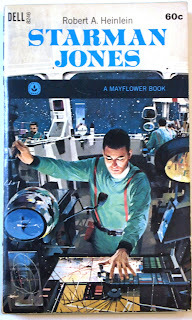
1. Starman Jones, Robert A Heinlein. This is my favorite of Heinlein book. Farm boy with a photographic memory inherits an astro-navigator's books and saves the day when the ship he is serving on gets lost. Or something like that. I think it is my favorite Heinlein because I liked his juveniles the best and this one has just a hint of romance in it that was quickly shut down. Heinlein didn’t do romance in his juveniles. The fact that I can still remember the basic plot of the story is telling since, I can’t say that for most of his juveniles. I reread it in my early 20’s and was surprised at how much of what I remembered wasn’t actually in the book. A testimonial to how much a young reader’s imagination adds to a story. Back in our day, at least, we spend our days making up stories while playing, and this skill lingered on into adolescence. From my records of the period, I can say that I rated it “E” for excellent together with Space Cadet, a book that I have no recollection of.
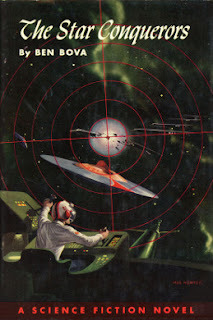 Credit: http://www.isfdb.org/cgi-bin/pl.cgi?2..., Fair use, https://en.wikipedia.org/w/index.php?...
Credit: http://www.isfdb.org/cgi-bin/pl.cgi?2..., Fair use, https://en.wikipedia.org/w/index.php?...2. The Star Conquers, Ben Bova. This book is a military SF, story with space battles, and an appealing young hero. Reading the Wikipedia description doesn’t bring back the story for me. I loaned this book to a friend 30 years ago to read to his son, and every time I see him he offers to return it, but since I know I'll not read it again, I tell him to keep it. Still it was a favorite of both of ours. I seem to recall that the sequel, Star Watchman wasn’t as good. I guess he wrote two more in the series years later. Who knew? I rated it a “E” back then.
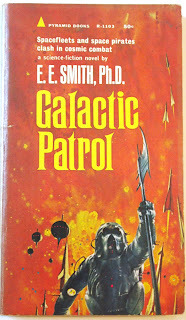
3. Galactic Patrol, E E Smith. The best book, by far, of the Lensmen series. A space opera on a vast scale. I haven’t reread it, and would likely find it too grand and nonsensical for my tastes these days. I made a galactic wargame board game out of it, at the time. Still, its another “E” book in ‘65.
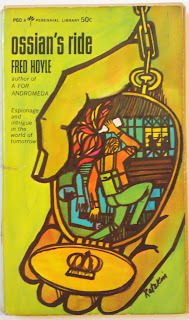
4.Ossian’s Ride, Fred Hoyle. An adventure set in Ireland. A recent graduate is recruited by British secret service as an amateur agent and sent to Ireland to discover the secret of a wildly successful company with amazing technology. It has a lot of hiking around Ireland, and, in a way, foreshadows my appreciation of the books like John Buchan’s 39 Steps which had his hero tramping around Scotland. I recently reread this book for the third time at least, and, indeed, I still enjoyed it. I first read it in 1966, but I wasn’t rating books that year, it seems.
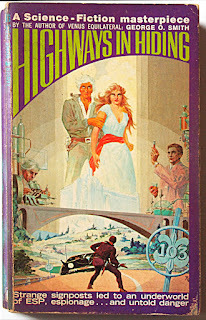
5. Highways in Hiding, George O Smith. To begin with, the version I have has a wonderfully evocative cover by Roy G Krenkel, The story is a mystery story that centers around two opposing secret organization dealing with a deadly disease brought back from space. Road signs are modified by one group to lead people in the know to contact agents. This is another book of travel, thought this time it was road trips around the pre-interstate US. At the time there seemed something romantic about getting into a car and taking to the open roads which appealed to me back in the day. These days, an hour in a car is about all I can take. No contemporary rating for this book either.
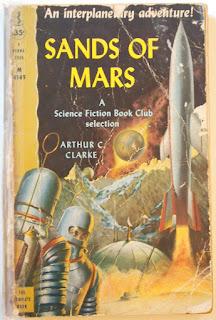
6. Sands of Mars, Arthur C Clarke. I count this as the first adult SF novel I read. How could you not like a book about Mars – a Mars still unexplored by remote spacecraft when I read it. A Mars that anything could go? The hero was a middle aged SF writer visiting Mars that he wrote SF books about early in his career, which seems a strange hero for a young teen. Indeed I find in my records of the time that in 1965 I rated it only a “B” so I guess its memory must’ve aged well. The thing is that I remember it when 97% of the books from that period I have no recollection of at all, That must mean something. Plus, I know I reread it. On the other hand, another Clarke book, Dolphin Island I rated an “E” though I believe it was a juvenile. In any event, I have no recollection of the story.
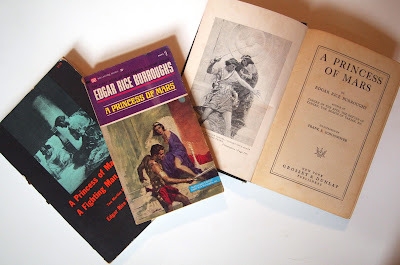
7. A Princess of Mars, Edgar Rice Burroughs. One of my perennial favorites. But even with so much to love about it, there's still so much I wish was better – bigger, fuller, with deeper characters. I’ve reread this book probably four or five times. I read it to the kids at bedtime. In 1971 I rated it ***½, which is a little above average. But like Sands of Mars, it seems to has aged well, and I now consider it the best of ERB's books. Contrast that with his Venus series that I rated “E” back in ‘65, but never have had any interest in rereading. The first three books of Barsoom are one of my favorites for all their flaws.
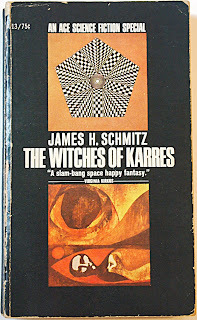
8. The Witches of Karres, James H Schmitz. I’ve read this book several times -- indeed, after pulling it out of the bookshelf for this post, I'm rereading and enjoying it once again. I’m a sucker for stories set on spaceship, and worm weather was such a cool idea. So cool, in fact, that I sort of borrowed it for an episode in my Bright Black Sea. I must have acquired the book prior to 1968 as it is on my inventory for that year, but I have no record of when I read it or my original rating.
The last two entries on this list are recent books (relatively speaking) and are still very much in favor.
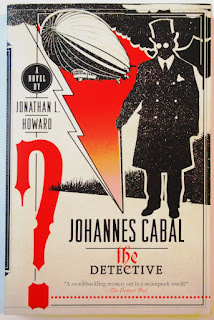
9.Johannes Cabal The Detective, Jonathan L Howard. This is one of my current favorite books. In fact, I just reread it. It is the second book in a series of five featuring the necromance Johannes Cabal, and is my favorite of the series, perhaps because it is a take on an old fashioned detective story and set in a mythical Balkan country, like A Prisoner of Zenda. Howard is one of those British authors with a clever, witty style that I really enjoy reading in my old age. Each book in the series is a little different, with a nod to Lovecraft, plus werewolves, vampires, and the devil himself. Normally these types of stories would not be my cup of tea, but his writing draws me in.
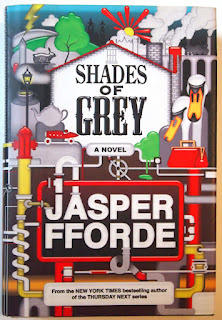
10, Shades of Grey, Jasper Fforde. This is my all time favorite speculative fiction book. In part because of Fforde's writing – cleaver, witty, endlessly imaginative, all of which plays a large part in my enjoyment of the story. It can be read as satire or absurd fiction, which again wouldn’t be my cup of tea, but not only is the writing wonderful, but he still manages to make the narrator and other characters seem like real people in a very unusual world where there is a strict cast system based on the color that they can see. I’ve read this book maybe four times – and will pick it up and read it again. I guess it’s my “comfort read.” Unfortunately its sales did not justify continuing on with the planned trilogy so that, Painting by Numbers, and The Gordini Protocols were never written, leaving so manymysteries left mysteries.The only bright side is that it did not give Fforde the chance to screw it up. I’ve read almost all of his adult novels and while the last two novels written after Shades of Grey were witty and endlessly imaginative, I couldn’t help wishing I was reading the last two books of the series. Life can be cruel.
So those are my nine favorite books. However, as a bonus, while looking up my old ratings for these books in my papers from the era, I found my top 22book list from the mid-1960's. Heinlein dominated it.
1 Starman Jones – Heinlein
2 Star Conquers – Bova
3 Tunnel in the Sky & The Stars are Ours! – Heinlein & Norton
4 Sixth Column – Heinlein
5 Galactic Patrol – EE Smith
6 Space Cadet & Farmer in the Sky – Heinlein
7 Dolphin Island & Islands in the Sky – Clarke
8 Time Traders – Norton
9 Crossroad of Time & Citizen of the Galaxy – Norton & Heinlein
10 Outside the Universe & Raiders from the Rings – Hamilton and Nourse
11 Sargasso of Space & Plague Ship – Norton
12 Space Viking – Piper
13 The Star Kings – Hamilton
14 Revolt on Alpha C – Silverberg
15 Robot Rocket – Rockwell
16 Venus Series – Burroughs
September 10, 2021
Sian / Molly, Mons, & Mars

As planned, I took most of the summer off from writing fiction. Summer is too fleeting to be stuck inside writing when it’s warm and daylight lingers. Once the weather gets cold and the days get short, I’ll be spending most of my time inside, and I can only play so many Microsoft solitaire games… Well, it’s September now, and while summer lingers on, it is time to ramp up writing.
As I may’ve mentioned in a previous post, I want to write a longer, more ambitious story than the last five of my stories, but alas, I haven’t come up with one yet. I tried. When I picture it, I see a vast white space – the story – with a little colorful dot – the characters and a locale. And that’s about it.
However, with the need to write, I’m going to start writing the sequel to Keireeas a stopgap project with the working title of Sian. Keiree was always intended to be the opening act of a novel length story, so I might as well get that project completed. Plus I need to get Gy Mons and Molly to a better place. I do have a story roughed in that takes them back to the locale of Gy’s birthplace – a throwback dissenting society (and now an independent nation) based on an ancient Asian culture – where he hopes to find shelter from all the haunting memories of his all too recent life with Keiree and the familiar but eerily altered Mars that he finds himself in. I don’t know how long the story will turn out to be – it’s pretty vague in the middle – but even it ends up as a novella, when combined with Keiree it would make for a novel length book. A combined Keiree and Sian would be long enough to publish as an omnibus paper book, tentatively titled Molly, Mons, & Mars, which is my goal.
With nothing beyond Sian, I’m in no rush to finish this book. I’ll put in my time each day, but, as always, I have no daily word count target to meet – and it’s going slow. My vague target release date is, well, let’s say, first quarter 2022. We’ll see how it goes.
